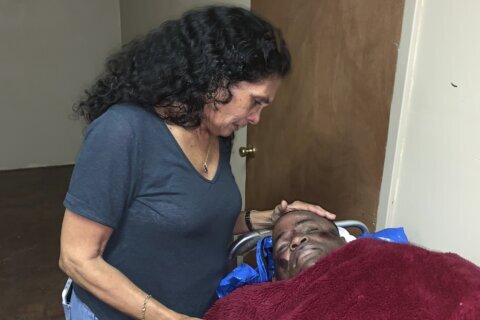NEW YORK (AP) — Through more than 200 years, the Sisters of Charity of New York nursed Civil War casualties, joined civil rights and anti-war demonstrations, cared for orphans, and taught countless children.
They’re proud of their history of selfless service. But they can’t ignore their current reality: The congregation continues to shrink and age — and not a single new sister has joined their U.S. group in more than 20 years.
After much prayer and contemplation, they made a tough decision that marked the beginning of the Catholic congregation’s end. They will no longer accept new members, and announced in an April 27 statement that they are now on a “path to completion.”
Sister Margaret Egan recalled that day and the emotional silence that filled the meeting room on their leafy Bronx campus when she and the other members of the order’s executive council accepted their reality and charted a new future. Grasping a roster of every sister who had ever served the congregation, they honored the women who preceded them.
“We just held up that book and said, ‘They’re here with us.’ (It’s) recognition that we’ve all done what God asked us to do,” said Egan, sitting in that same meeting room days after the announcement.
It was Mother Elizabeth Ann Seton who set their lengthy mission of service into motion when she sent three sisters to New York City in 1817 to start an orphanage. Eight years prior, in Maryland, Seton had founded the Sisters of Charity — the first community for religious women in the U.S.
In New York, their mission expanded to schools and hospitals. In 1846 the Sisters of Charity of New York spun off into a separate order.
Over the decades, they opened schools, colleges and hospitals; launched missions in the Bahamas and Guatemala; protested the Vietnam War and were arrested for doing so during Mass at St. Patrick’s Cathedral in 1972. They continued to serve people on society’s margins, including immigrants, the homeless and the aging.
Their numbers ballooned, peaking in the 1960s with 1,300 nuns. Today, they have 154; their median age is 85.
That drop reflects a global trend. The number of Catholic nuns is in a free fall as fewer young women devote their lives to religious orders.
The number of religious sisters in the U.S. peaked in 1965 at 178,740, and has sharply declined to 39,452 sisters in 2022, according the Center for Applied Research in the Apostolate at Georgetown University.
Several of the Sisters of Charity in New York serving today made their vows in the 1950s and the 1960’s; they have witnessed this drop in real time. But that has not diminished their congregation’s legacy nor the many ways they’ve personally changed the lives of New Yorkers.
On a recent day, six sisters on the executive council shared their hopes and reminisced as they gathered at their headquarters on the College of Mount Saint Vincent, which evolved from an academy founded by the congregation in 1847.
Sister Donna Dodge, the congregation president, recounted a favorite memory — the unsolicited praise that followed them as they marched along Fifth Avenue in a St. Patrick’s Day parade.
“As we passed, many of them came out and said, ‘Thank you for teaching me. Thank you for helping me in the hospital. Thank you! Thank you!’” she said. “It was the first time in my life that I’ve ever heard that from so many people at once, because we don’t do what we do to look for thanks. We do what we do because it’s right … and it’s a Gospel mandate.”
In decades past, operating the order’s hospitals and schools afforded the sisters leadership opportunities that were off limits to women elsewhere in society, said Sister Margaret O’Brien.
Eventually more avenues for leadership opened up for all women, including nuns across the U.S. who’ve become champions for social justice causes and leaders of vast hospital networks. In a recent historic reform, Pope Francis gave women voting rights at a global meeting of bishops.
But members of the Sisters of Charity in New York had hoped for more, said O’Brien, who lamented that women still cannot be Catholic priests.
“Back in the ’70s, in a lot of our documents and assembly minutes, you can see the hope that we had at the time for the ordination of women,” she said. “And that’s much slower in coming … but it will come.”
The sisters took turns sharing their experiences while sitting beneath a 19th century painting of the order’s founder, Seton, who became the first saint born in what would become the U.S. A word that guides their life — charism — came up repeatedly. It is defined as “an extraordinary power (as of healing) given a Christian by the Holy Spirit for the good of the church.”
They also spoke of all the changes. In their beginnings, the Sisters of Charity nuns wore long black dresses and bonnets. They gradually began to wear a modified version of the habit and eventually secular clothes.
This came after reforms that followed the Second Vatican Council, which brought the 2,000-year-old church into the modern era. Some wondered if the updates to the life of the church eventually contributed to their recent decision to stop accepting new sisters.
“When something like this is looming, you think, ‘What did we do wrong?’” O’Brien said. “I’m sure there were many times when we questioned all those changes that we made back in the seventies — the habit, leaving schools, going into other various ministries.”
“But when you stop and think, you recognize that each person who did any of those things was doing it in faith, trying to read the signs of the time, and do what they’re called to do. And that can’t be wrong.”
Sister Dorothy Metz agreed.
“I don’t think that we ever got too involved in the blame game,” she said. “We knew we were subject to many societal changes that affected our ministries and our way of life.”
Together, they’ve also faced personal challenges. Sister Claire Regan said she’s been blessed by the love and support she’s received from other sisters while she’s been battling stage 4 cancer. She also drew parallels between the finality of her life and her congregation’s end.
“Not only did I receive the response of community and love and charity, but also God’s wisdom and grace to take this time to pause and to recognize in my personal story of what is completion,” she said.
Today, some of the nuns offer ministry to sisters in retirement. Others help with food preparation and distribution at pantries, work at the college, or travel to the order’s mission in Guatemala.
For fun, they dance, sing and play instruments (Sister Egan is a drummer) – or listen to music (the ringtone on Sister Dodge’s cell phone is from the theme song of “Jaws”). They enjoy a laugh and some good-natured competition.
The sisters recently purchased two golf carts to save on gas while driving on campus. Dodge beamed recalling how she challenged the president of the College of Mount Saint Vincent to a golf cart race down a hill.
“Life is very serious … But at the same time, you have to be balanced and try to look for some joy in the moment,” Dodge said. “And for me, that was joy.”
The Sisters of Charity remain hopeful. Their recent decision will only impact the order’s New York branch; they trust that faithful lay people will take over their work and sustain the spirit of their mission.
“We’ve handed the torch over to people who…have the charism of charity and the spirit of the Sisters of Charity,” Dodge said. “They’ll take that into the future, and they’ll pass it on to another generation.” __
Associated Press religion coverage receives support through the AP’s collaboration with The Conversation US, with funding from Lilly Endowment Inc. The AP is solely responsible for this content.
Copyright © 2024 The Associated Press. All rights reserved. This material may not be published, broadcast, written or redistributed.






